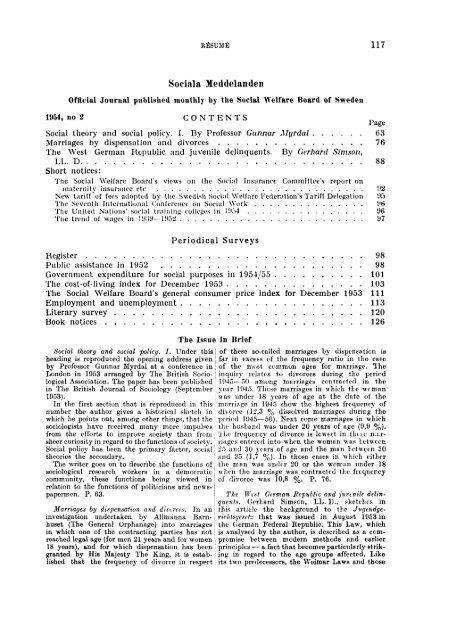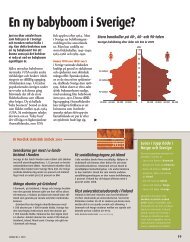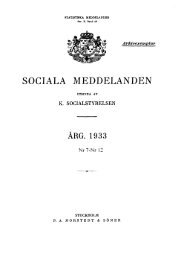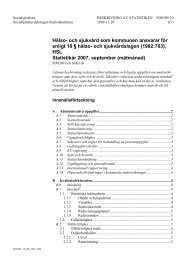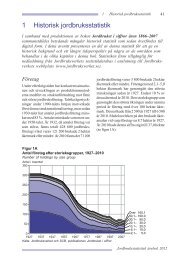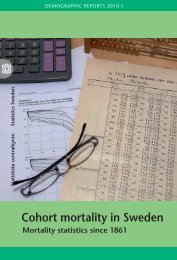Sociala meddelanden. 1954: 1-6 (pdf) - Statistiska centralbyrån
Sociala meddelanden. 1954: 1-6 (pdf) - Statistiska centralbyrån
Sociala meddelanden. 1954: 1-6 (pdf) - Statistiska centralbyrån
You also want an ePaper? Increase the reach of your titles
YUMPU automatically turns print PDFs into web optimized ePapers that Google loves.
RÉSUMÉ 117<br />
<strong>Sociala</strong> Meddelanden<br />
Official Journal published monthly by the Social Welfare Board of Sweden<br />
<strong>1954</strong>, no 2 CONTENTS<br />
Page<br />
Social theory and social policy. I. By Professor Gunnar Myrdal 63<br />
Marriages by dispensation and divorces 76<br />
The West German Republic and juvenile delinquents. By Gerhard Simson,<br />
LL. D 88<br />
Short notices:<br />
The Social Welfare Board's views on the Social Insurance Committee's report on<br />
maternity insurance etc 92<br />
New tariff of fees adopted by the Swedish Social Welfare Federation's Tariff Delegation 95<br />
The Seventh International Conference on Social Work 96<br />
The United Nations' social training colleges in <strong>1954</strong> 96<br />
The trend of wages in 1939—1952 97<br />
Periodical Surveys<br />
Register 98<br />
Public assistance in 1952 98<br />
Government expenditure for social purposes in <strong>1954</strong>/55 101<br />
The cost-of-living index for December 1953 103<br />
The Social Welfare Board's general consumer price index for December 1953 111<br />
Employment and unemployment 113<br />
Literary survey 120<br />
Book notices 126<br />
Social theory and social policy. I. Under this<br />
heading is reproduced the opening address given<br />
by Professor Gunnar Myrdal at a conference in<br />
London in 1953 arranged by The British Sociological<br />
Association. The paper has been published<br />
in The British Journal of Sociology (September<br />
1953).<br />
In tile first section that is reproduced in this<br />
number the author gives a historical sketch in<br />
which he points out, among other things, that the<br />
sociologists have received many more impulses<br />
from the efforts to improve society than from<br />
sheer curiosity in regard to tho functions of society.<br />
Social policy has been the primary factor, social<br />
theories the secondary.<br />
The writer goes on to describe the functions of<br />
sociological research workers in a democratic<br />
community, these functions being viewed in<br />
relation to the functions of politicians and newspapermen.<br />
P. 63.<br />
The Issue in Brief<br />
Marriages by dispensation and divorces. In an<br />
investigation undertaken by Allmänna Barnhuset<br />
(The General Orphanage) into marriages<br />
in which one of the contracting parties has not<br />
reached legal age (for men 21 years and for women<br />
18 years), and for which dispensation lias been<br />
granted by His Majesty The King, it is established<br />
that the frequency of divorce in respect.<br />
of these so-called marriages by dispensation is<br />
far in excess of the frequency ratio in tho case<br />
of the most common ages for marriage. The<br />
inquiry relûtes to divorces during the period<br />
1045—50 among marriages contracted in the<br />
year .1945. Those marriages in which the woman<br />
was under 18 years of age at the date of the<br />
marriage in 1945 show the highest frequency of<br />
divorce (12,3 % dissolved marriages during the<br />
period 1945—50). Next come marriages in which<br />
the husband was under 20 years of age (9,9 %).<br />
'i he frequency of divorce is lowest in thi.ic marriages<br />
entered into when the woman was between<br />
25 and 30 years of age and the man between 30<br />
and 35 (1,7 %). In those cases in which either<br />
the man was undtr 20 or the woman under 18<br />
when the marriage was contracted the frequency<br />
of divorce was 10,8 %. P. 76.<br />
The West German Eepullic and jurinile delinquents.<br />
Gerhard Simeon, LL. D., sketches in<br />
this article the background to the Jvgendgericlitsgesetz<br />
that was issued in August 1953 in<br />
the German Federal Republic. This Law, which<br />
is analysed by the author, is described as a compromise<br />
between modern methods and earlier<br />
principles — a fact that becomes particularly striking<br />
in regard to the age groups affected. Like<br />
its two predecessors, the Weimar Laws and those


